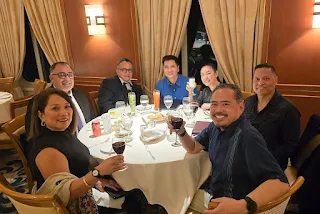When I was younger, I used to compare and contrast my skin
tone to my sisters’ skin tones. My eldest sister had the lightest skin. My
middle sister had the darkest skin. My skin was found somewhere in the middle.
My eldest ate used cosmetics, like
Eskinol, to keep a fairer complexion. We could only find these types of
products at the local Filipino market or at Seafood City. My second eldest ate, who usually got negative comments
on her darker complexion, refrained
from using the products.
Source: Belo Men Ad
I wanted to try these products for myself, but was advised
not to because of my young age. I had no idea what the products did. I had no
idea why my family used them. I just knew that I wanted it. I wanted to look
like my eldest sister so that people wouldn’t say that I wasn’t light enough.
Filipinos, along with other brown Asians, have been
contrasted to East Asians and their hyped stereotypes. Unfortunately, the
popular ideology of colorism within the larger APIA community has trickled down
into our own Filipino community.
The Philippines’ colonial past haunts our community. A bad
omen that has helped socialize us into thinking that whiter is better. Skin
lightening products advertised around the Philippines, and throughout the
continent, reinforce this idea. This new form of white supremacy stigmatizes
Filipinos with darker skin tones and adds to an anti-black ideology that many
Asians, including Filipinos, have adopted.
The racial hierarchy based on skin color is made up. It was
created by Filipino oppressors, but also reinforced by Filipino society.
Despite the fact that it’s all fake, colorism and stigmas on darker skin tones
have real consequences.
Why is it that most of the major Filipino stars in the
Philippines have lighter skin tones? This inherently attaches a monetary value
to people’s actual bodies. Folks with lighter complexions are thought to be of
an upper class or even more desirable in society’s eyes. Filipino American
celebrities with darker skin are praised – ultimately claimed by the larger
Filipino community because they are famous and well known in American society.
Colorism and white supremacy linger over our heads,
influencing a lot of our everyday thoughts and feelings of people who are in
our community, and even those who are not in our community. These
skin-lightening products that bombard our lives reinforce the popular
Anti-Black sentiment that many Asians, including Filipinos, have adopted.
In honor of Filipino American History Month, I feel as
though it is important to celebrate being Filipino, in every aspect of the
identity. It’s important to appreciate, love, and accept every facet of being a
Filipino. Along with celebration, it’s important to think critically of our
positions, having and lacking privilege. I think that in order to truly love
being Filipino, you have to be able to critique what Filipino-ness looks like
within the larger APIA community and society in general.
Yes, I am trying to call out our community. No, I am not
saying that all Filipinos are anti-black. No, I am not saying that all
Filipinos want to lighten their skin. Yes, I am saying that we as a larger
Filipino community can do better in terms of loving others. We as a larger
Filipino community can do better in terms of loving ourselves.
Filipinos are multi-faceted. We come in lots of different
shapes and colors. We must be accepting of all of our differences in order to
become a stronger community for our future. I love my people, and its time for
us to love each other together.
Isang Bagsak
Isang Bagsak



















0 Comments
Hi! Thank you for dropping by. Please leave us a comment.